Sub-Saharan Africa is the area of Africa that is south of the Sahara Desert. It has four different regions—West Africa, East Africa, Central Africa, and Southern Africa. Each region has many different cultures and people. Almost two-thirds of the people in Sub-Saharan Africa are Bantu. The Bantu people belong to the same language group. They speak similar languages and have similar customs.
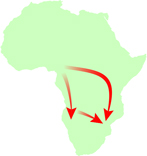
Find Lake Chad on the map on page 136. About 1000 B.C., Bantu-speaking people from the Lake Chad region migrated across Sub-Saharan Africa. The Bantu settled in almost every Sub-Saharan region. This movement of Bantu people into new areas is called the Bantu migration. It continued for almost fifteen hundred years. The Bantu people spread agriculture. They introduced new crops. They grew bananas and grains, such as millet and sorghum (sohr-gum). The Bantu taught people how to make iron tools and weapons. These people were successful. They knew how to grow crops and make tools.
Early kingdoms in West Africa were located along major trade routes to North Africa. See the map of the region on page 136. The people followed Islam. West Africa was rich in gold. North Africans had salt to trade. Salt was as valuable as gold. It would be centuries before electricity or refrigerators were invented. People used salt to preserve (prepare for future use) food in hot climates. Salt is also an important part of a person’s diet. West Africa grew very rich from the gold and salt trade.
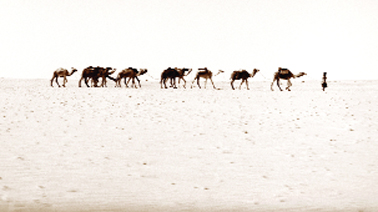
A salt caravan in the Sahara
About 1300, the empire of Mali (mah-lee) controlled all of the Sahara trade routes. A Mali king named Sunjata set up an organized system of government. A great Mali city was Timbuktu (tim-buk-too). See map on page 136. It was a center of art and culture. The city had a famous university. By the 1500s, the kingdom of Songhai (sawng-hy) conquered Mali. The Portuguese and other Europeans sailed along the west coast of Africa. The Portuguese introduced new goods and new ocean trade routes. The sea routes were faster, and ships could carry large cargos. The desert trade routes died. As a result, the African traders lost income.
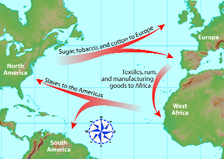 Trade Between West Africa, Europe, and the North American Colonies
Trade Between West Africa, Europe, and the North American Colonies
In the 1500s, the European colonies in North America needed labor. Europeans built trading posts along the west coast of Africa. They brought rum, guns, and other goods to trade for West African slaves. Slavery is the owning of people by other people. The slaves were shipped to American colonies. The slave trade ended in the 1800s. By then, ten to twelve million Africans had been sold into slavery. The slave trade affected the people of Africa by separating families and denying people their freedom. The population also suffered as young Africans were taken away from their homes. Slave trade also brought guns into Africa.
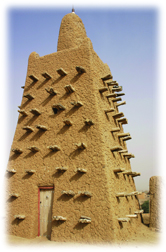 Ancient mosque in Timbuktu, Mali
Ancient mosque in Timbuktu, Mali
About A.D.700, Arabs began to trade with the people of East Africa. See the map of the region on page 136. Over time, the two cultures formed a new African culture and language. It was called Swahili (swah-hee-lee). Swahili is an Arabic word meaning “on the coast.”
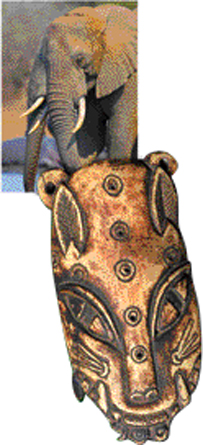 A mask carved from ivory. Ivory comes from the tusks of elephants. Today it is illegal to kill an elephant for ivory.
A mask carved from ivory. Ivory comes from the tusks of elephants. Today it is illegal to kill an elephant for ivory.
The Swahili became Muslims. Their African language mixed with Arabic to become the Swahili language. On the map, find the East Africa region. Now find Mogadishu and Mombasa. They were important trading centers. These cities along the Indian Ocean traded with Asia and Europe. Traders in East Africa traveled I along the coast in ships with one sail called dhows.
East Africa also had a slave trade. East Africans, Arabs, and L Europeans all captured Africans and sold them throughout I Africa and Southwest Asia. Most of the slaves went to Islamic countries. Europeans used slave labor to build large sugarcane plantations in the region.
When the slave trade ended, Europeans traded in products, such as ivory, gold, and rubber. To control these natural resources, Europe established colonies. Britain controlled much of East Africa. In the 1800s, Britain and other European powers divided up most of Africa.
Central Africa has some of the highest mountains and biggest rivers in Africa. See the map of the region on page 136. In the middle of the region is the Congo Basin. Two important river systems are the Congo and the Zambezi (zam-bee-zee) rivers. They are important trade and transportation routes.
Bantu-speaking people moved into Central Africa about 2,000 years ago. They set up several kingdoms. About 1300, the Kongo Kingdom began at the mouth of the Congo River. They developed trade routes with West and East Africa. They became very rich and powerful. The Kongo people traded animal skins, slaves, and ivory. Ivory comes from the tusks of elephants.
About 1500, Europeans came to the region. They wanted ivory and forest products. Some African kingdoms traded with them. In the late 1800s, European countries wanted more. They divided the region among themselves. France, Belgium, Germany, Spain, Britain, and Portugal all created colonies. A colony is a territory ruled by another nation.
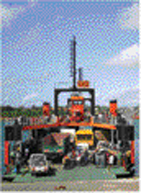
Locals taking the ferry to work, Mombasa, Kenya
The countries drew borders. They ignored the homelands of the different ethnic groups. Africans in many colonies did not speak the same language. They did not have the same customs. These differences in language and customs caused problems after the colonies became independent.
Europeans used imperialism to keep power over their colonies. Imperialism is the practice of one country forcefully controlling the government, trade, and culture of another country.
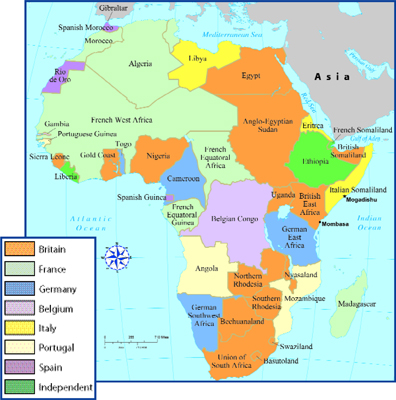
Historical Map: European Colonies in Africa, 1914
Southern Africa is rich in natural resources. See the map of the region on page 136. The most valuable resources are minerals like gold. The first people who lived in Southern Africa were hunter-gatherers. They were called the Khoisan.
During the Bantu migrations, a group of people called the Shona built a great empire. Their capital was named Great Zimbabwe. It was the largest of over one hundred stone towns in southern Africa. Shona rulers controlled the gold trade in the region. They traded with the Swahili in East Africa and with China. When the gold trade declined in the 1400s, Great Zimbabwe lost its importance.
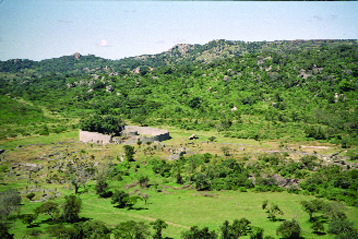 View of Great Zimbabwe enclosure. The remains of the valley complex can be seen in front of it.
View of Great Zimbabwe enclosure. The remains of the valley complex can be seen in front of it.
In the late 1400s, the Dutch from the Netherlands were the first Europeans to settle in South Africa. They brought in slaves from Southeast Asia to work in their colony near the Cape of Good Hope.
The Cape sits at the tip of Africa. Soon other Europeans settled on the Cape. Dutch, German, and French settlers were called Afrikaners.
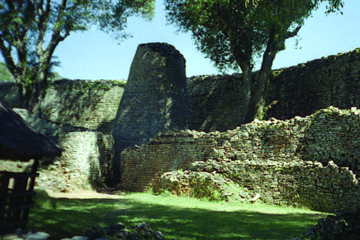 A conical tower inside the enclosure
A conical tower inside the enclosure
Over time, a new language developed in the Cape colony. It was called Afrikaans. The language combined Dutch, Bantu, and Khoisan. English, French, and German also influenced the language. In the early 1800s, the British took over the Cape area. Afrikaner farmers did not like British rule, so they moved farther east and north.
In the early 1900s, South Africa was ruled by white Afrikaners. The government became increasingly more racist against black South Africans. The white government created a policy called apartheid, which means “apartness.” Apartheid separated the races and divided them into four groups: whites, blacks, coloreds, and Asians. Colored and Asian people could live only in certain areas. Each African tribe or group was given its own “homeland.” The homelands did not include good farmland, mines, or natural resources.
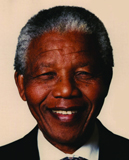
During apartheid, many blacks worked in white-owned businesses and industries. They had to live in separate areas called townships. The townships were poor and crowded. They were far from the cities and the jobs.
In 1912, a group called the African National Congress (ANC) formed. The ANC fought for the civil rights of black South Africans. Nelson Mandela was a leader of the ANC. He spent 26 years in prison because he fought against apartheid.
In the late 1980s, South Africa moved to end apartheid. In 1990, Mandela was released from prison. In 1994, all South Africans were given the right to vote. Nelson Mandela was elected the first black j president of South Africa.
Primary Sources
“Let there be work, bread, water and salt for all.”
Nelson Mandela
Who Are the People of Sub-Saharan Africa?
There are many nations and hundreds of different ethnic groups in Sub-Saharan Africa. Some of the country names are almost the same. This can be very confusing. Geographers divide Africa into five regions. You have already learned about the region of North Africa. The area south of the Sahara Desert, or Sub-Saharan Africa, has four regions. Find each of the four regions on the map. The regions help you identify people and places in Africa, and learn how they are alike and how they are different.
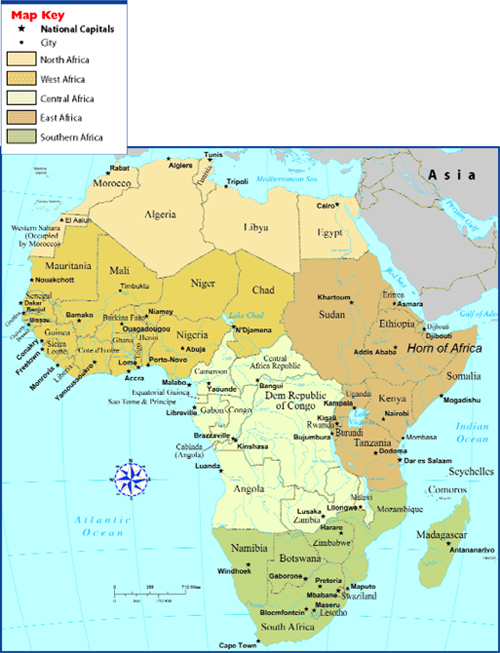 Regional Map of Africa
Regional Map of Africa
There are many different ethnic groups in West Africa. Their culture mixes traditions from Africa, Europe, and Arab countries. There are hundreds of different languages in the region. This makes communication very difficult. Some people speak European languages, such as English or French.
Years ago, when Europeans made political boundaries, they separated some ethnic groups. Some groups did not get along. This caused conflicts. Some of the largest groups in West Africa are Hausa, Fulani, Igbo, and Yoruba.
Most of West Africa is rivers and plains. The only good areas for farming are along the rivers. The rest of the region has poor soil. Along the coast, people fish for food. There is not much wood for building. Village houses are round and made of mud or mud bricks. The roofs are made of straw. Women paint the walls for decoration. Family is very important. Parents, children, and close relatives live together in the same village or in modern houses or apartments in the city. Families celebrate special events.
The two most common religions are Christianity and Islam. Islam came from the Arab traders in North Africa. Europeans brought Christianity. West Africans in the Sahel region follow Islam. Most of the people south of the Sahel are Christians.
An important celebration in West Africa is the time when boys and girls become adults. People wear beautiful wooden masks. People believe that the wearer becomes what the mask represents.
The main dishes in West Africa are made from root vegetables, such as yams or sweet potatoes. People also use meat, dried fish, and vegetables to make stews. Nigeria and coastal parts of West Africa like hot, spicy food.
Look at the region of East Africa on the map on page 136. Find the area labeled the Horn of Africa. This area is a peninsula. It is named for its shape, which looks like the horn of a rhinoceros. Most of the population in the Horn of Africa lives in Ethiopia.
The Swahili people live along coastal areas of East Africa. Most Swahili live in cities. They are African Muslims. The Swahili mixed Indian, Arabic, and African culture and architecture with their own traditions. The cities of Mogadishu, Pate, Lamu, Mombasa, and Zanzibar are all important trading centers. Swahili fishermen sail traditional boats called dhows. They have used dhows for hundreds of years to trade along the east coast of Africa.
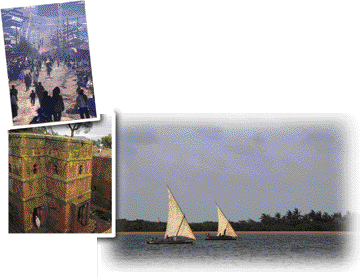 A street in Debark, northern Ethiopia
A street in Debark, northern Ethiopia
A church in Lalibela,
Fishermen in their dhows
Many East Africans follow animist religions. Animism is the belief that things in nature, such as an animal, tree, or body of water, have a spirit. Most animists also worship their ancestors. Some people combine animism with Christianity or Islam. Most Christians live in Ethiopia. Sudan and Somalia are mostly Muslim. The region suffers from conflicts between Christians and Muslims.
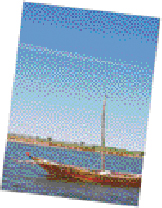 A fishing boat on Lake Victoria
A fishing boat on Lake Victoria
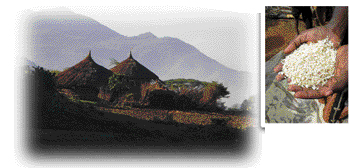 Wooden huts in Ethiopia. Note the mountainous terrain.
Wooden huts in Ethiopia. Note the mountainous terrain.
Casava root is eaten in many rural areas of Africa.
The food in East Africa is special because most people do not eat meat. They use their cattle, sheep, and goats as a form of I money. The animals are not used for food. Arab culture plays a role in East African food. People like rice cooked with spices. . They use saffron, cloves, cinnamon, and pomegranate juice.
Ethiopia was the first area in the world to grow coffee. Coffee drinking spread from Ethiopia to Yemen. From Yemen, it spread to Arabia and then to the rest of the world. Ethiopians drink coffee in a special ceremony, similar to the Japanese tea ceremony.
Ethiopia was never colonized by the Europeans. The rugged mountains made it hard for Europeans to enter Ethiopia.
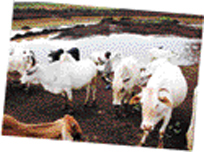
A boy tending to cattle at a watering hole in southern Ethiopia
Many different groups live in Central Africa. Some groups are hunter-gatherers. They live in the tropical rain forests. The word “Ba” means people. Some of the rain forest people are the Bambuti, Batwa, Bayaka, and Bagyeli. They live by hunting animals, fishing, gathering honey, and digging for wild yams and other plants. All of these groups have ties to villages. They trade forest products with villagers for food and other goods.
Their forest homelands are threatened by logging, or cutting down trees for lumber and firewood. When the forests are cleared, the plants and animals the people depend on for food are gone. In some areas, the government has taken their land to make national parks. The Batwa live in eastern Democratic Republic of Congo, Rwanda, Burundi, and Uganda. Almost all the forests where they live have been destroyed.
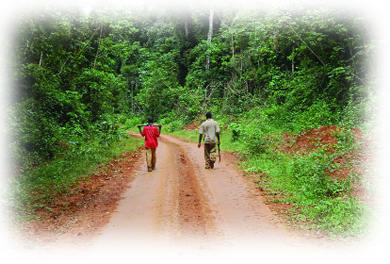 Two Baka men walk down a logging road. Many forest homelands are threatened by logging.
Two Baka men walk down a logging road. Many forest homelands are threatened by logging.
The Bundu people of Zambia believe the Zambezi River has a spirit. They call this spirit Nyami Nyami. It brings them water to grow crops and fish to eat. So they call the river “the river of life.” The river flows through Angola, Botswana, Zimbabwe, and finally to Mozambique. Many people in Central and Southern Africa depend on this river for life.
A beautiful area along the river is in Zimbabwe. It is called Victoria Falls. These falls are twice as big as Niagara Falls at the border between the United States and Canada.
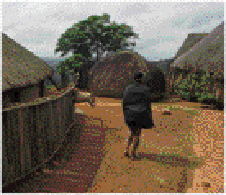 A Zulu village
A Zulu village
The region of Southern Africa has forests, grasslands, and deserts. It is rich in natural resources, such as platinum, gold, diamonds, and copper. Many different ethnic groups, or tribes, live here. They include the Zulu, Xhosa, Shona, and San.
The San are hunter-gatherers. They have lived in the Kalahari Desert for thousands of years. Their petroglyphs, or rock paintings, are the oldest art on the African continent. One of their special ceremonies is a dance. The San believe that the dancers heal people in the community.
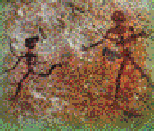
Rock paintings in a cave in South Africa
Two great leaders in South Africa come from the Xhosa culture. They are Archbishop Desmond Tutu and Nelson Mandela. Archbishop Tutu won the 1984 Nobel Peace Prize (a prize given to a person who works for the good of all people) for his work to give black Africans equality in South Africa. In 1994, Nelson Mandela became the first black African to be elected president of South Africa.

Beautiful Zulu beadwork adorns a glass bottle.
The Zulu are the largest ethnic group in South Africa. They are well known for their beautiful brightly colored beads and baskets as well as small carvings.
Primary Sources
The British fought the Zulu nation for control of their land. This is what the Zulus thought of the Europeans entering their land.
“… . They resemble [look like] us, but in appearance are the color of pumpkin-porridge [oatmeal]… They are rude of manners and without any graces or refinement. They carry a long stick of fire. With this they kill and loot [steal] from many nations.”
—From a Zulu poem in Emperor Shaka the Great, translated by Mazisi Kunene.
What Is Sub-Saharan Africa Like Today?
In West Africa, some countries, like Niger, have poor farmland and not many natural resources. Only 3 percent of the land in Niger is good for farming. Nigeria, however, is rich in natural resources. But it does not grow enough food to feed its people.
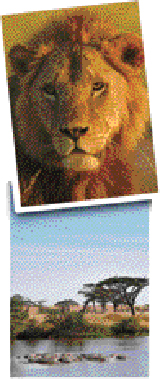
Lion in Amboseli National Park, Kenya
Hippo pool in Serengeti National Park, Kenya
Some countries in the region have governments that do not meet the needs of their people. Government officials take money that belongs to the people. Ghana and Cote d’Ivoire, or Ivory Coast, are also 1 rich in resources, such as gold and timber. But they have civil wars. A civil war is a conflict between different groups within a country. Wars, droughts, and failures of governments cause famines. Famine is an extreme shortage of food. Other countries and organizations in the p world must send food. If not, millions of people die from starvation.
Some countries in East Africa, such as Tanzania and Kenya, make money from tourism. Tourists go on safaris to see wild animals. Tanzania is rich in gold and diamonds, but the country is poor and needs money to build a transportation system. The capitals of both countries are modern cities.
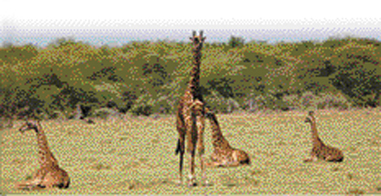
Giraffes in Lake Manyara National Park, Tanzania
Sudan is the largest country in Africa. For many years, Muslims and Christians in Sudan have fought against each other. Each group wants to control the country. Millions of people suffer because of the fighting. Recently, a genocide is occurring in a part of Sudan called Darfur. Genocideis the intentional killing of a group of people. Tens of thousands of black Sudanese have been killed by an Arab militia group.
The region of Central Africa is rich in minerals and other natural resources. But most of the people live in rural areas. They are poor farmers. There are no railroads or ports to transport resources to market.
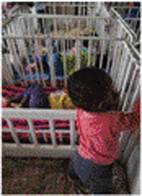
Child in an orphanage. Many children are orphans because of AIDS.
Disease is also a problem in this region. Many people have malaria. It is a disease spread by mosquito bites. Malaria is the number one cause of death in Central Asia. Another terrible disease is HIV. This virus causes AIDS. Hundreds of thousands of people die of AIDS each year in Central Africa. There is no cure. Because so many people die of disease, Central Africa has a very young population.
Population growth is a big problem in Sub-Saharan Africa. High population growth rates mean that people use more resources. They need more food, water, and energy. In 1950, the population of Africa was about 222 million. By 1990, the population was 661 million. In 2006, the population is about 840 million. These numbers show that there has been a population explosion in Africa.
What are the reasons for the fast population growth? Health care is better. As a result, more people live longer. More children are born and live to become adults. It is also the custom for African women to have many children. Children help feed the family and take care of parents in old age.
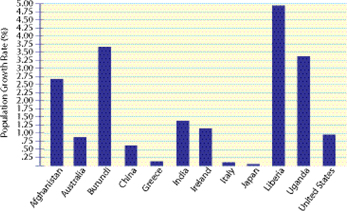 Comparison of the Population Growth Rates in Twelve Countries, 2006
Comparison of the Population Growth Rates in Twelve Countries, 2006
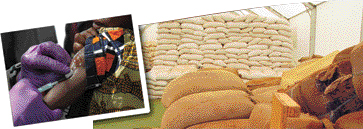
Vaccination programs help keep the population healthy
Other countries donate corn when there are food shortages
Life is better in many of the countries in Southern Africa than any other area of the continent. Namibia, Botswana, and South Africa have good leaders and governments. They have strong economies. There are jobs in new factories. Other countries have started businesses there.
Zimbabwe, on the other hand, has resources. However, war and debts have hurt the economy. A few white farmers owned most of the land. In 2000, the government took land from the white farmers and gave it to black native people. Many white farmers left the country. Many of the new owners were inexperienced farmers. There has been a shortage of food for everyone.
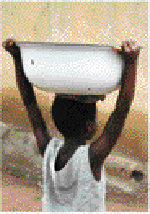 Few people have running water in their homes. Water has to be collected from a well shared by the community.
Few people have running water in their homes. Water has to be collected from a well shared by the community.
Sub-Saharan Africa faces many challenges. There are wars and famine. Droughts and deforestation hurt the environment. Population growth has led to terrible poverty.
In 2001, an organization called the African Union (AU) was started to meet these challenges. The African Union (AU) is a group of 53 African nations. The purpose of the AU is to build j democracies in Africa, end wars and conflicts, secure human rights, and create better economies. Just like the European Union, the AU plans to have one currency for all member countries. They also want one military force. The member states plan to make one common market with no taxes.
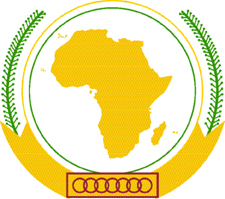 African Union Symbol
African Union Symbol
| Country | Major Export |
|---|---|
| Botswana | diamonds |
| Burundi | coffee |
| Gambia | peanuts |
| Guinea | bauxite (used in aluminum) |
| Kenya | tea |
| Nigeria | oil |
| Malawi | tobacco |
| Mauritius | sugar |
| Niger | uranium ore |
| South Africa | gold |
| Sudan | cotton |
| Zambia | copper |









